wheel CHEVROLET CAMARO 1997 4.G Owners Manual
[x] Cancel search | Manufacturer: CHEVROLET, Model Year: 1997, Model line: CAMARO, Model: CHEVROLET CAMARO 1997 4.GPages: 404, PDF Size: 20.96 MB
Page 5 of 404
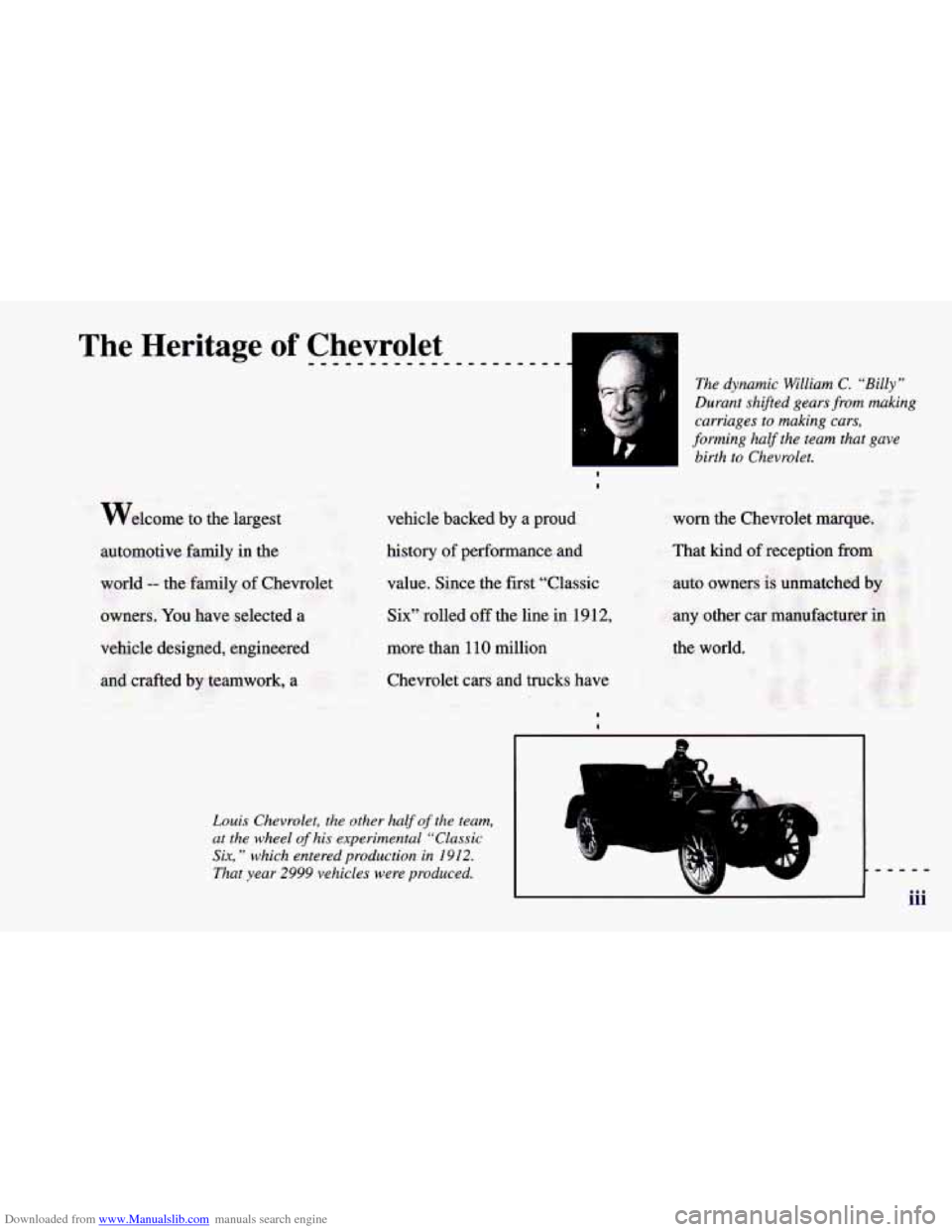
Downloaded from www.Manualslib.com manuals search engine welcome to the largest
automotive family in the
world
-- the family of Chevrolet
owners.
You have selected a
vehicle designed, engineered
and crafted by teamwork, a
The dynamic William C. “Billy”
Durant shifed gears from making
carriages to making
cars,
forming half the team that gave
- birth to Chevrolet.
I
I
vehicle backed by a proud
history of performance and worn the Chevrolet marque.
That kind
of reception from
value. Since the first “Classic auto owners is unmatched by
Six” rolled off the line in 191 2, any other car manufacturer in
more than 1 10 million
Chevrolet cars and trucks have
I
Louis Chevrolet, the other half of the team,
at the wheel
of his experimental “Classic
Six, ” which entered production in 1912.
That year 2999 vehicles were produced.
iii
Page 18 of 404
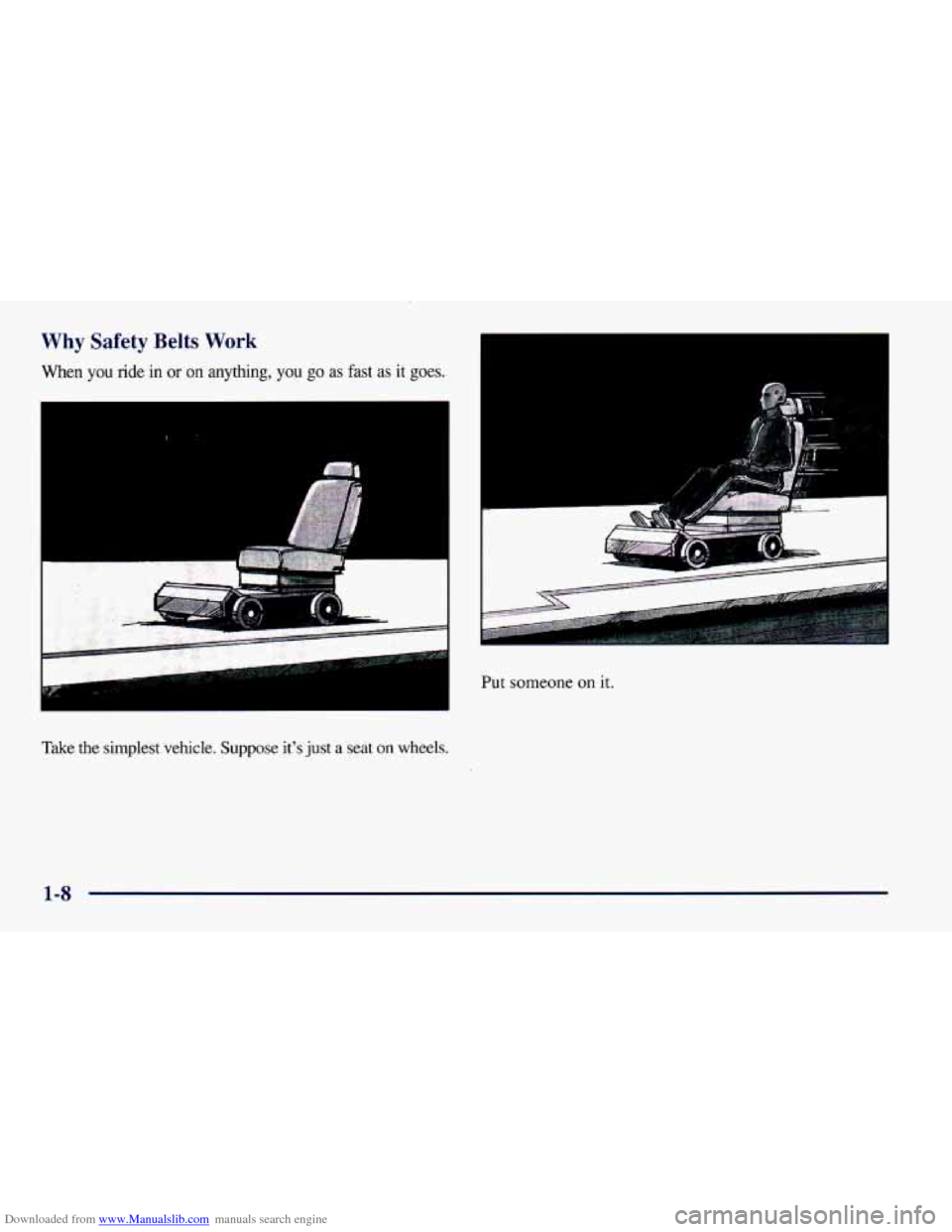
Downloaded from www.Manualslib.com manuals search engine Why Safety Belts Work
When you ride in or on anything, you go as fast as it goes,
Take the simplest vehicle. Suppose it's just
a seat on wheels. Put someone
on
it.
143
Page 32 of 404
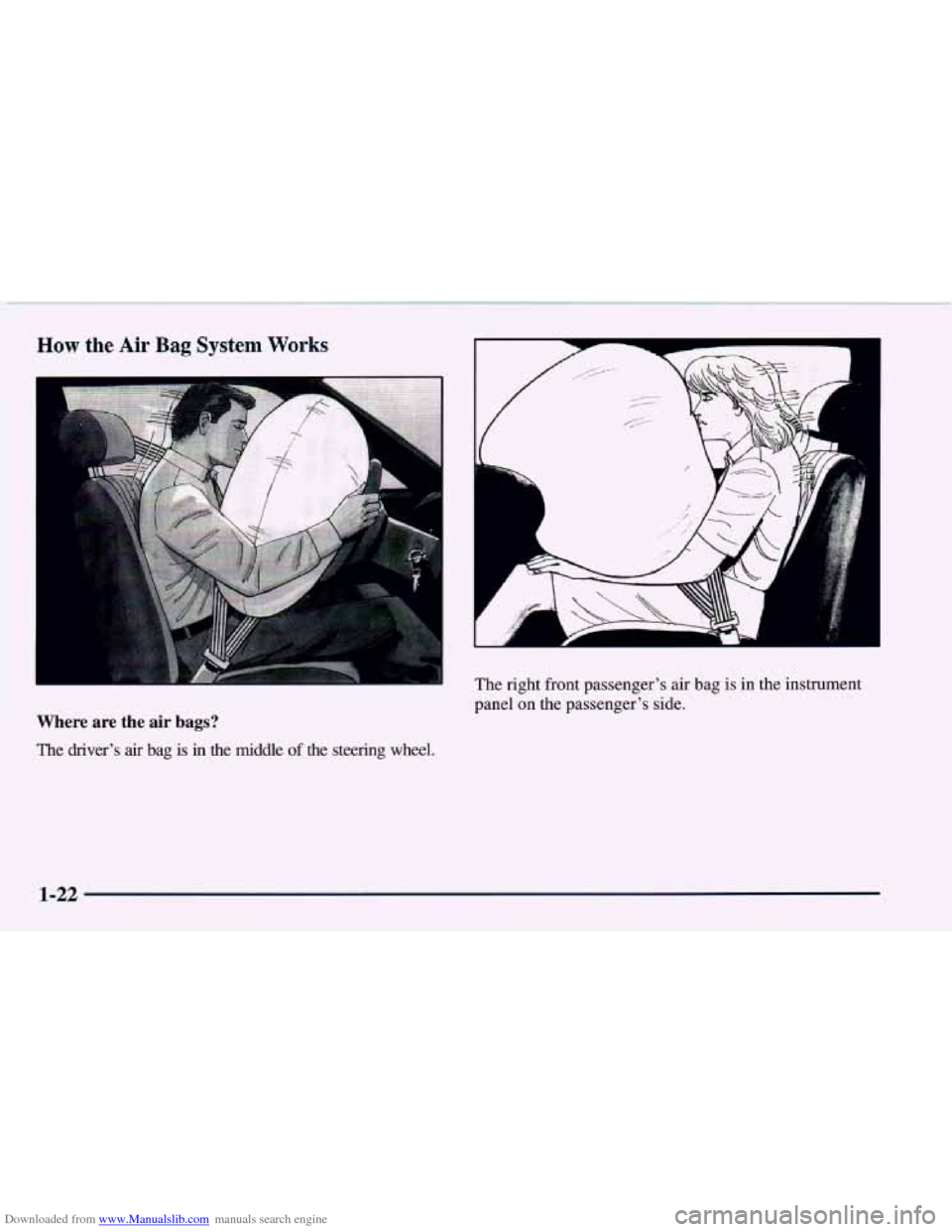
Downloaded from www.Manualslib.com manuals search engine How the Air Bag System Works
Where are the air bags?
The driver’s air bag is in the middle of the steering wheel.
A
A
The right front passenger’s air bag is in the instrument
panel on the passenger’s
side.
1-22
Page 33 of 404
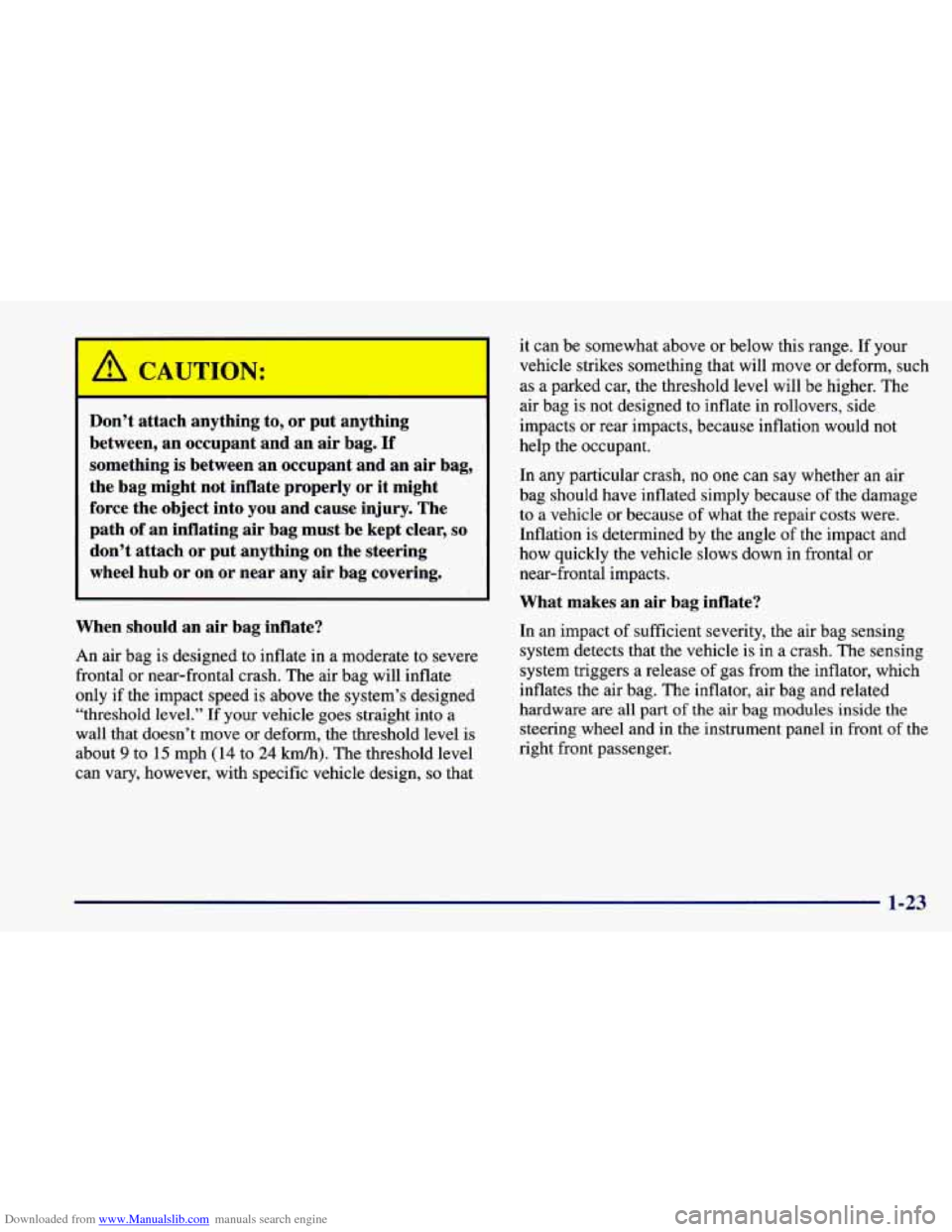
Downloaded from www.Manualslib.com manuals search engine Don’t attach anythmg to, or put anytnmg
between, an occupant and an air bag.
If
something is between an occupant and an air bag,
the bag might not inflate properly or it might
force the object into you and cause injury. The
path
of an inflating air bag must be kept clear, so
don’t attach or put anything on the steering
wheel hub or on or near any air bag covering.
When should an air bag inflate?
An air bag is designed to inflate in a moderate to severe
frontal or near-frontal crash. The air bag will inflate
only if the impact speed is above the system’s designed
“threshold level.”
If your vehicle goes straight into a
wall that doesn’t move or deform, the threshold level is
about
9 to 15 mph (14 to 24 km/h). The threshold level
can vary, however, with specific vehicle design,
so that
it can be somewhat above or below this range. If your
vehicle strikes something that will move or deform, such
as a parked car, the threshold level will be higher. The
air bag is not designed to inflate in rollovers, side
impacts or rear impacts, because inflation would not
help the occupant.
In any particular crash, no one can say whether an air
bag should have inflated simply because of the damage
to a vehicle or because of what the repair costs were.
Inflation is determined by the angle of the impact and
how quickly the vehicle slows down in frontal or
near-frontal impacts.
What makes an air bag inflate?
In an impact of sufficient severity, the air bag sensing
system detects that the vehicle is in a crash. The sensing
system triggers a release of gas from the inflator, which
inflates the air bag. The inflator, air bag and related
hardware
are all part of the air bag modules inside the
steering wheel and in the instrument panel in front of the
right front passenger.
1-23
Page 34 of 404

Downloaded from www.Manualslib.com manuals search engine How does an air bag restrain?
In moderate to severe frontal or near-frontal collisions,
even belted occupants can contact the steering wheel or the
instrument panel.
Air bags supplement the protection
provided by safety belts. Air bags distribute the force of
the impact more evenly over the .occupant’s upper body,
stopping the occupant more gradually. But air bags would
not help you in many types of collisions, including
rollovers, rear impacts and side impacts, primarily because
an occupant’s motion is not toward those
air bags. Air
bags should never be regarded as anything more than a
supplement to safety belts, and then only in moderate to
severe frontal or near-frontal collisions.
When an air bag inflates, there is dust in the air.
This dust could cause breathing problems for
people with a history of asthma or other
breathing trouble.
To avoid this, everyone in the
vehicle should get out as soon
as it is safe to do so.
If you have breathing problems but can’t get out
of the vehicle after an air bag inflates, then get
fresh air by opening a window or door.
What will you see after an air bag inflates?
After an air bag inflates, it quickly deflates, so quickly
that some people may not even realize the air bag
inflated. Some components
of the air bag module in the
steering wheel hub for the driver’s air bag, or the
instrument panel for the right front passenger’s bag, will
be hot for a short time.
The parts of the bag that come
into contact with you may be warm, but not too hot to
touch. There will be some smoke and dust coming from
vents in the deflated air bags. Air bag inflation doesn’t
prevent the driver from seeing or from being able
to
steer the vehicle, nor does it stop people from leaving
the vehicle. In
many crashes severe enough
to inflate an air bag,
windshields are broken by vehicle deformation.
Additional windshield breakage may also occur from the
right front passenger air bag.
Air bags are designed to inflate only once. After they
inflate, you’ll need some new parts for your air bag
system. If
you don’t get them, the air bag system
won’t be there to help protect you in another crash.
A new system will include air bag modules and
possibly other parts. The service manual for your
vehicle covers the need to replace other parts.
Page 35 of 404

Downloaded from www.Manualslib.com manuals search engine 0 Your vehicle is equipped with a crash sensing and
diagnostic module, which records information
about the air bag system. The module records
information about the readiness of the system, when
the sensors are activated and driver’s safety belt
usage at deployment.
0 Let only qualified technicians work on your air bag
system. Improper service can mean that your
air bag system won’t work properly. See your
dealer for service.
Servicing Your Air Bag-Equipped
Chevrolet
Air bags affect how your Chevrolet should be serviced.
There are parts of the air bag system in several places
around your vehicle.
You don’t want the system to
inflate while someone is working on your vehicle.
Your Chevrolet dealer and the Camaro Service Manual
have information about servicing your vehicle and the
air bag system. To purchase a service manual, see
“Service and Owner Publications” in the Index.
NOTICE:
If you damage the covering for the driver’s or the
right front passenger’s
air bag, the bag may not
work properly. You may have to replace the
air
bag module in the steering wheel or both the air
bag module and the instrument panel for the
right front passenger’s
air bag. Do not open or
break the
air bag coverings. For up
to
10 minutes after the ignition key is
turned off and the battery is disconnected, an air
bag can still inflate during improper service. You
can be injured
if you are close to an air bag when
it inflates. Avoid wires wrapped with yellow tape
or yellow connectors. They are probably part of
the air bag system. Be sure to follow proper
service procedures, and make sure the person
performing work for you is qualified to do
so.
The air bag system does not need regular maintenance.
1-25
Page 51 of 404
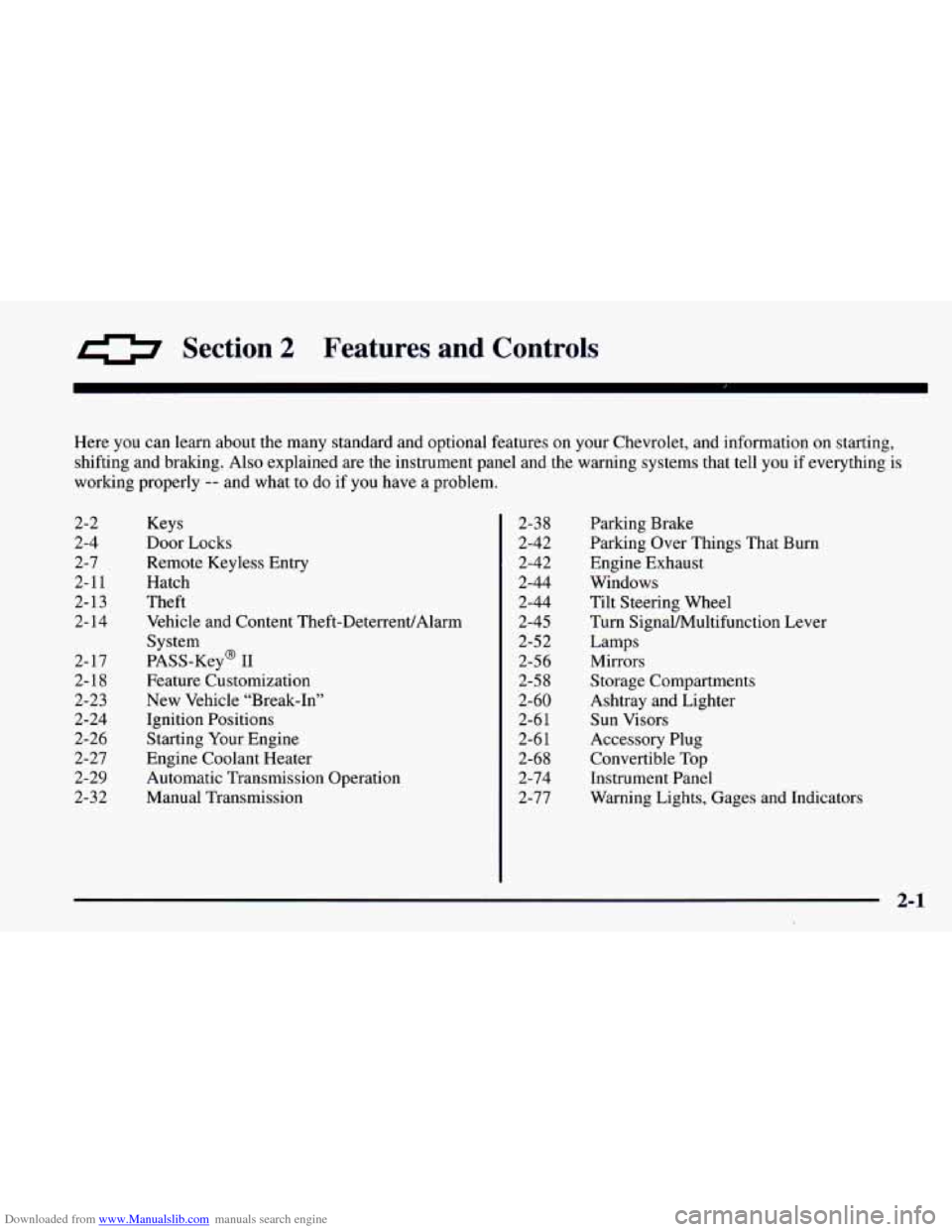
Downloaded from www.Manualslib.com manuals search engine a Section 2 Features and Controls
Here you can learn about the many standard and optional features on your Chevrolet, and information on starting,
shifting and braking. Also explained are the instrument panel and the warning systems that tell you
if everything is
working properly
-- and what to do if you have a problem.
2-2
2-4 2-7
2-1
1
2-13 2- 14
2-17
2-18
2-23
2- 24
2-26
2-27
2-29
2-32 Keys
Door Locks
Remote Keyless Entry
Hatch
Theft Vehicle and Content Theft-DeterrentIAlarm
System
PASS-Key@
I1
Feature Customization
New Vehicle “Break-In”
Ignition Positions
Starting Your Engine
Engine Coolant Heater
Automatic Transmission Operation
Manual Transmission
2-3 8
2-42
2-42
2-44
2-44
2-45
2-5 2
2-56
2-5
8
2-60
2-6
1
2-6 1
2-68
2-74
2-77 Parking Brake
Parking Over Things That Burn
Engine Exhaust
Windows
Tilt Steering Wheel
Turn Signalhlultifunction Lever
Lamps
Mirrors Storage Compartments
Ashtray and Lighter
Sun Visors
Accessory Plug
Convertible Top
Instrument Panel
Warning Lights, Gages and Indicators
2-1
Page 63 of 404

Downloaded from www.Manualslib.com manuals search engine When you park your Chevrolet and open the driver’s
key from the ignition and take it with you. Always do
NOTICE: door, you’ll hear a chime reminding you to remove your
If you put things in the hatchback area, be sure
they won’t break the glass when you close it.
Never
slam the hatch down. You could break the
glass or damage the defogger grid (if equipped).
this. Your steering wheel will be locked, and so will
your ignition. If you have an automatic transmission,
taking your
key out also locks your transmission. And
remember
to lock the doors.
I I Parking at Night
On vehicles with the Vehicle and Content
Theft-DeterrenUAlarm System: The hatch switch will
not work while the system
is armed. See “Vehicle and
Content Theft-DeterrendAlarm System” in the Index.
Theft
Vehicle theft is big business, especially in some cities.
Although your Chevrolet
has a number of theft-deterrent
features, we know that nothing we put
on it can make it
impossible
to steal. However, there are ways you can help.
Key in the Ignition
If you leave your vehicle with the keys inside, it’s an
easy target for
joy riders or professional thieves -- so
don’t do it. Park
in a lighted spot, close all windows and lock your
vehicle. Remember to keep your valuables
out of sight.
Put them in a storage area, or take them with
you.
Parking Lots
If you park in a lot where someone will be watching
your vehicle, it’s best to lock
it up and take your keys.
But what if you have to leave your ignition key? What
if
you have to leave something valuable in your vehicle?
0 Put your valuables in a storage area, like your trunk
or glove box.
0 Lock the glove box.
@ Lock all the doors except the driver’s.
Then take the
door key with you.
2-13
Page 64 of 404
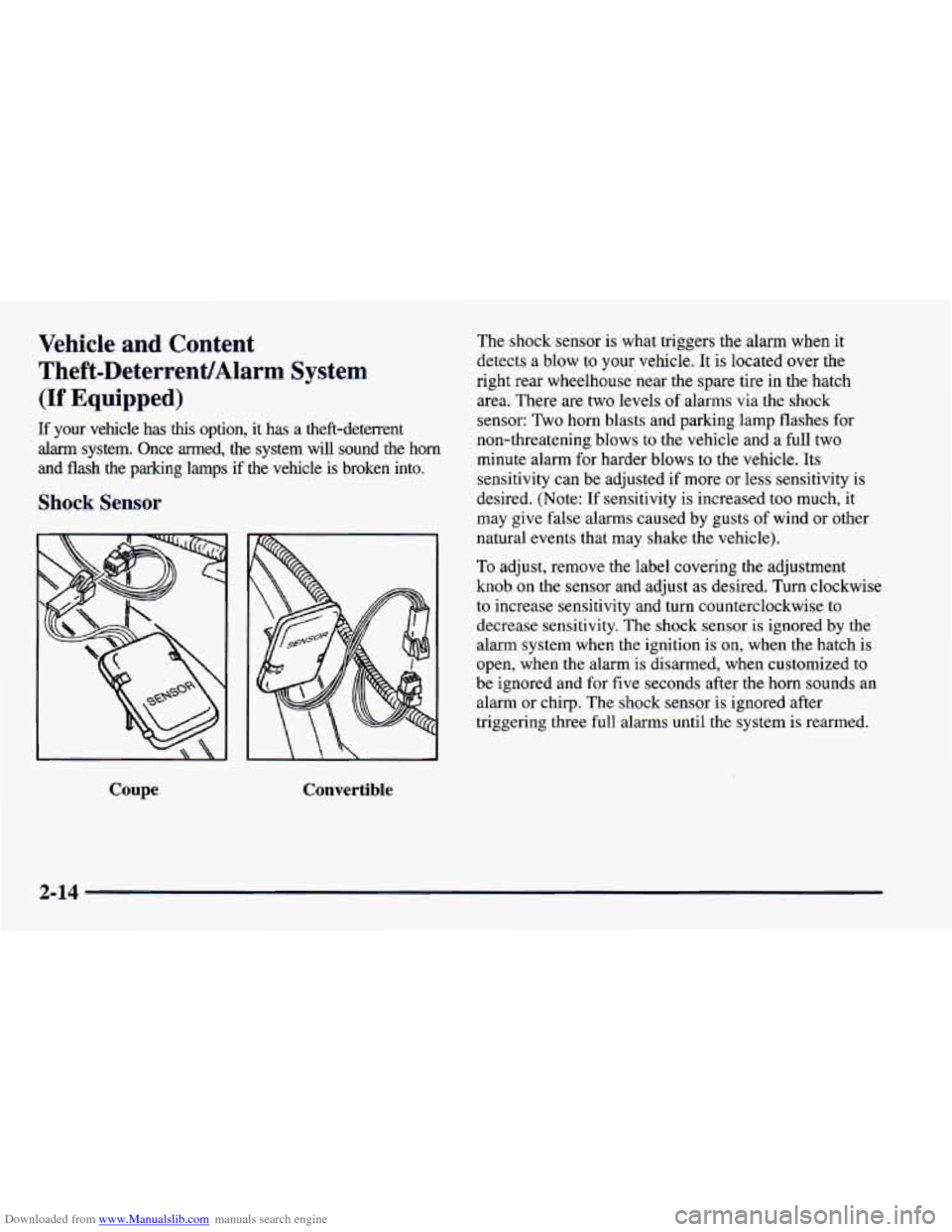
Downloaded from www.Manualslib.com manuals search engine Vehicle and Content
Theft-DeterrenVAlarm
Sysl
(If Equipped)
If your vehicle has this option, it has a theft-deterrent
alarm system. Once armed, the system will sound the horn
and flash the parking lamps if the vehicle is broken into.
Shock Sensor
To adjust, remove the label covering the adjustment
knob on the sensor and adjust
as desired. Turn clockwise
to increase sensitivity and turn counterclockwise to
decrease sensitivity. The shock sensor is ignored
by the
alarm system when the ignition is on, when the hatch is
open, when the alarm is disarmed, when customized
to
be ignored and for five seconds after the horn sounds an
alarm or chirp. The shock sensor is ignored after
triggering three full alarms until the system is rearmed.
Coupe Convertible
The shock sensor is what triggers the alarm when it
detects
a blow to your vehicle. It is located over the
right rear wheelhouse near the spare tire in the hatch
area. There are two levels
of alarms via the shock
sensor: Two horn blasts and parking lamp flashes for
non-threatening blows to the vehicle and
a full two
minute alarm for harder blows to the vehicle. Its
sensitivity can be adjusted if more
or less sensitivity is
desired. (Note: If sensitivity is increased too much, it
may give false alarms caused by gusts
of wind or other
natural events that may shake the vehicle).
2-14
Page 74 of 404

Downloaded from www.Manualslib.com manuals search engine Ignition Positions
With the ignition key in the ignition switch, you can turn
the switch to five positions.
C
A E
ACC (A): Position in which you can operate your
electrical power accessories. Press in the ignition switch
as you turn the top
of it toward you.
LOCK (B): The only position in which you can remove
the key. This locks your steering wheel, ignition and
automatic transmission.
If you have an automatic transmission, the ignition
switch can’t be turned
to LOCK unless the shift lever is
in the PARK
(P) position.
OFF (C): Unlocks the steering wheel, ignition and
automatic transmission, but does not send electrical
power to any accessories. Use this position if your
vehicle must be pushed or towed.
A warning tone will
sound if you open the driver’s door when the ignition
is
in OFF and the key is in the ignition.
RUN (D): Position to which the switch returns after
you start your engine and release
the switch. The switch
stays in the
RUN position when the engine is running.
But even when the engine is
not running, you can
use
RUN to operate your electrical power accessories
and to display some instrument panel warning and
indicator lights.
2-24